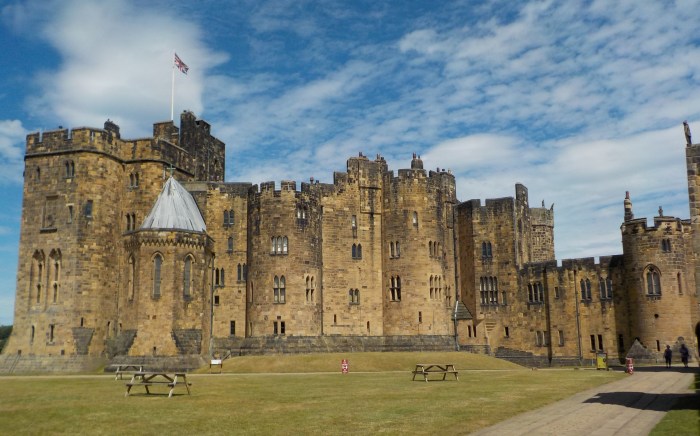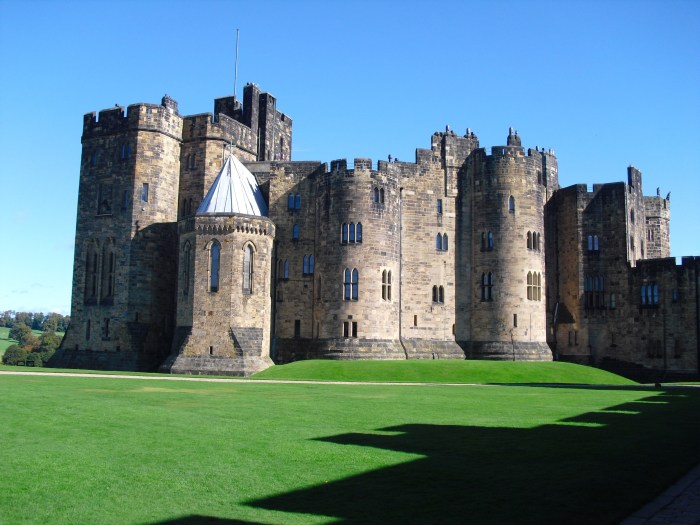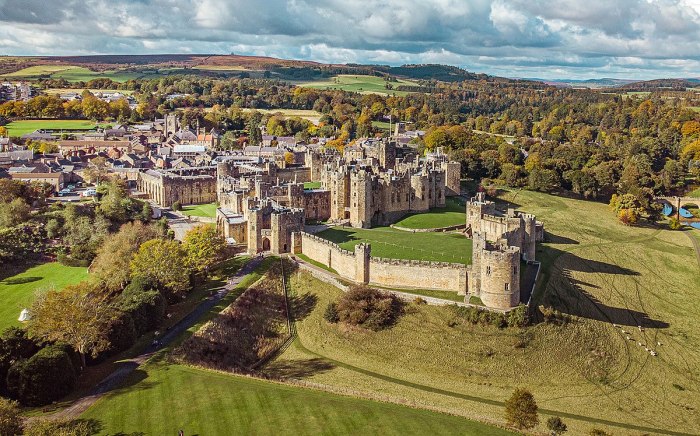Alnwick Castle, a magnificent architectural marvel in Northumberland, England, stands as a testament to centuries of rich history, stunning architecture, and cultural significance. Its imposing presence has captivated the imaginations of countless visitors, inspiring awe and admiration.
From its humble origins as a wooden motte-and-bailey fortress in the 11th century to its present-day grandeur as a private residence and popular tourist destination, Alnwick Castle has played a pivotal role in shaping the tapestry of British history. Its strategic location on the Scottish border made it a vital stronghold during medieval conflicts, and it has witnessed numerous sieges and battles over the centuries.
Alnwick Castle’s History
Alnwick Castle, a medieval fortress with a rich and storied past, has played a pivotal role in British history for centuries. Its origins can be traced back to the 11th century, when it was first constructed as a wooden fortification by the Normans. Over the centuries, it has undergone numerous expansions and renovations, evolving into the magnificent castle we see today.
Norman Origins
In 1096, William the Conqueror granted the Barony of Alnwick to his loyal follower, Ivo de Vesci. Ivo constructed a wooden castle on a strategic hilltop overlooking the River Aln, establishing the foundation of Alnwick Castle.
Medieval Expansion
In the 12th century, the de Vesci family began expanding the castle, replacing the wooden structures with stone fortifications. They added a keep, towers, and a curtain wall, transforming it into a formidable stronghold. The castle played a crucial role in defending the northern border of England during the Scottish Wars of Independence.
Percy Ownership
In 1309, the de Vesci family sold Alnwick Castle to the Percy family, who would become its most famous owners. The Percys, Earls of Northumberland, made significant additions to the castle, including the gatehouse, the Barbican, and the Middle Ward. Alnwick Castle became the seat of the Percy family and a symbol of their power and influence.
Tudor and Stuart Era, Alnwick castle
During the Tudor and Stuart eras, Alnwick Castle continued to be a significant royal residence. King Henry VIII visited the castle in 1541 and ordered extensive renovations. In the 17th century, the castle was besieged during the English Civil War, but it successfully resisted attack.
18th and 19th Centuries
In the 18th and 19th centuries, Alnwick Castle underwent significant architectural changes. The 4th Duke of Northumberland commissioned Robert Adam to design the state rooms, giving the castle its current neoclassical appearance. The castle also became a popular tourist destination, attracting visitors from all over the country.
20th and 21st Centuries
In the 20th century, Alnwick Castle was used as a military hospital during World War II. After the war, it was restored to its former glory and became the residence of the Duke and Duchess of Northumberland. Today, Alnwick Castle is open to the public and is one of the most popular tourist attractions in Northumberland.
Architectural Features

Alnwick Castle is a splendid example of medieval architecture, showcasing a captivating blend of Norman and Gothic styles. Its robust towers, turrets, and battlements narrate tales of its defensive prowess, while its opulent interiors whisper of grandeur and comfort.
Towers and Turrets
The castle’s formidable towers and turrets played a crucial role in its defense. The massive Keep, standing at 112 feet tall, served as the last line of defense and provided panoramic views of the surrounding countryside. Flanking the Keep are the Hotspur and Lion Towers, each boasting intricate carvings and arrow slits that once rained down projectiles upon attackers.
When visiting the grand Alnwick Castle, it’s important to remember the essentials. A beach holiday packing list can provide guidance for packing appropriate attire, sunscreen, and other necessities for a day trip to the nearby coastline. Upon returning to the castle, one can marvel at its stunning architecture and immerse themselves in its rich history.
Interior Grandeur
Beyond its imposing exterior, Alnwick Castle boasts an opulent interior that reflects its aristocratic heritage. The State Rooms, with their soaring ceilings and ornate furnishings, were designed to impress visitors and showcase the wealth and power of the Percy family. The Drawing Room, with its magnificent chandeliers and delicate silk curtains, exudes an aura of elegance and refinement.
Alnwick Castle, a majestic architectural marvel, offers a captivating glimpse into history. While exploring its enchanting grounds, consider venturing beyond the castle walls to experience the serene beauty of eco-lodges nestled amidst the tranquil countryside. Immerse yourself in nature’s embrace and return to Alnwick Castle refreshed and rejuvenated, ready to delve further into its timeless allure.
Gardens and Grounds
The gardens and grounds of Alnwick Castle are a breathtaking sight to behold. Spanning over 42 acres, they are a masterpiece of horticultural design and offer a serene escape into nature’s embrace.
The gardens are meticulously landscaped with a variety of plants and flowers, each chosen for its beauty and fragrance. Visitors can wander through formal gardens, where manicured lawns and hedges create a sense of order and symmetry. The Rose Garden is a riot of color, with over 3,000 roses in bloom from June to October.
The Poison Garden
One of the most unique features of Alnwick Castle’s gardens is the Poison Garden. Created in 2005, it is home to over 100 poisonous plants from around the world. The garden is a fascinating educational tool, teaching visitors about the dangers of plants that can kill or harm. However, visitors are not allowed to touch or smell the plants, as even a small amount of contact can be dangerous.
Water Features
Water plays an important role in the design of Alnwick Castle’s gardens. The cascade waterfall is a stunning centerpiece, tumbling down a series of stone steps into a tranquil pool. Other water features include the Grand Cascade, a series of fountains and pools that create a dramatic spectacle, and the Serpentine Lake, a picturesque body of water that meanders through the grounds.
Current Use and Events

Today, Alnwick Castle remains a private residence for the Duke and Duchess of Northumberland. However, the castle is also open to the public as a major tourist attraction, drawing visitors from around the world.
Events and Activities
Throughout the year, Alnwick Castle hosts a wide range of events and activities that cater to diverse interests. These include:
- Jousting Tournaments: The castle’s courtyard transforms into a medieval battlefield during jousting tournaments, where knights in shining armor engage in thrilling displays of horsemanship and combat.
- Music Festivals: Alnwick Castle’s picturesque grounds provide a stunning backdrop for music festivals, featuring performances by renowned artists from various genres.
- Guided Tours: Visitors can explore the castle’s grand interiors and learn about its rich history through guided tours led by knowledgeable experts.
- Educational Programs: The castle offers educational programs for children and adults, focusing on history, architecture, and nature.
- Private Events: Alnwick Castle can be rented for private events, such as weddings, corporate functions, and film productions.
Role in Film and Television
Alnwick Castle’s unique and imposing architecture has made it a popular filming location for numerous movies and television shows. Some notable productions that have featured the castle include:
- Harry Potter and the Sorcerer’s Stone (2001)
- Robin Hood (2010)
- Downton Abbey (2010-2015)
- Transformers: The Last Knight (2017)
These productions have further raised the castle’s profile and contributed to its enduring popularity as a cultural and historical landmark.
Cultural and Artistic Significance

Alnwick Castle has been a prominent source of inspiration for artists, writers, and musicians throughout history. Its unique architectural features, stunning gardens, and rich history have captured the imaginations of countless creatives.
In literature, the castle has been featured in numerous works, including Sir Walter Scott’s “Marmion” and Elizabeth Gaskell’s “Wives and Daughters.” The castle’s grand halls and dramatic battlements have provided a captivating backdrop for tales of love, intrigue, and adventure.
Art
Alnwick Castle has also been a popular subject for artists. Its picturesque exterior and elaborate interiors have been depicted in paintings, drawings, and sculptures by renowned artists such as J.M.W. Turner and John Constable. The castle’s unique architectural features, including its towers, turrets, and crenellations, have made it a favorite subject for landscape painters.
Music
The castle’s rich history and associations with royalty have also inspired musical compositions. The “Alnwick Castle March” by Thomas Dunhill is a well-known piece that celebrates the castle’s grandeur and heritage. Other musical works inspired by the castle include the “Alnwick Castle Waltz” by Johann Strauss II and the “Alnwick Castle Suite” by Percy Grainger.
Alnwick Castle is a magnificent castle located in Northumberland, England. It has been featured in many films and television shows, including Harry Potter and the Sorcerer’s Stone. If you’re looking for a great hike after visiting the castle, check out some of the best hiking trails in the US.
You won’t be disappointed! After your hike, be sure to return to Alnwick Castle for a tour of its beautiful gardens and staterooms.
Comparisons to Other Castles: Alnwick Castle
Alnwick Castle stands as a testament to medieval architecture and holds its own among other notable castles in the United Kingdom and Europe. While each castle possesses unique characteristics, they share commonalities in architectural style, historical significance, and current use.
Architectural Style
- Alnwick Castle: Norman and Gothic Revival styles, with elements of Baroque and Renaissance
- Windsor Castle: Predominantly Gothic, with influences from Norman and Victorian styles
- Edinburgh Castle: Mixture of medieval, Renaissance, and Victorian architecture
- Neuschwanstein Castle (Germany): Romantic Revival style, inspired by medieval castles
- Château de Chambord (France): Renaissance style, known for its elaborate ornamentation
Historical Significance
Each castle has played a significant role in its respective country’s history:
- Alnwick Castle: Border stronghold against Scottish raids, later became a residence for the Percy family
- Windsor Castle: Royal residence since the 11th century, used for state occasions and ceremonies
- Edinburgh Castle: Military fortress and royal residence, played a key role in Scottish history
- Neuschwanstein Castle: Built as a retreat for King Ludwig II of Bavaria, became a symbol of German Romanticism
- Château de Chambord: Hunting lodge for King Francis I of France, showcases the grandeur of the French Renaissance
Current Use
Today, these castles serve various purposes:
- Alnwick Castle: Home to the Duke of Northumberland, open to the public for tours and events
- Windsor Castle: Official residence of the British monarch, used for state functions and royal ceremonies
- Edinburgh Castle: Military garrison, tourist attraction, and home to the Scottish Crown Jewels
- Neuschwanstein Castle: Popular tourist destination, offering tours and stunning views of the Bavarian Alps
- Château de Chambord: UNESCO World Heritage Site, open to the public for guided tours and exhibitions
Comparative Table
| Castle | Architectural Style | Historical Significance | Current Use |
|---|---|---|---|
| Alnwick Castle | Norman, Gothic Revival, Baroque, Renaissance | Border stronghold, Percy family residence | Private residence, open to the public |
| Windsor Castle | Gothic, Norman, Victorian | Royal residence, state occasions | Official residence of the British monarch |
| Edinburgh Castle | Medieval, Renaissance, Victorian | Military fortress, royal residence, Scottish history | Military garrison, tourist attraction, Scottish Crown Jewels |
| Neuschwanstein Castle | Romantic Revival | Royal retreat, German Romanticism | Tourist destination, stunning views |
| Château de Chambord | Renaissance | Hunting lodge, French Renaissance | UNESCO World Heritage Site, guided tours |
Final Thoughts

Today, Alnwick Castle continues to enchant visitors with its breathtaking beauty and fascinating history. Its stunning gardens, exquisite interiors, and captivating events make it a must-visit destination for anyone seeking a glimpse into the grandeur of the past and the vibrant spirit of the present. As we bid farewell to this architectural masterpiece, we leave with a profound appreciation for its enduring legacy and the unforgettable memories it has etched in our minds.
Question Bank
Is Alnwick Castle open to the public?
Yes, Alnwick Castle is open to the public during certain times of the year. Visitors can explore the castle’s state rooms, gardens, and grounds, and participate in various events and activities.
What is the significance of the Poison Garden at Alnwick Castle?
The Poison Garden at Alnwick Castle is a unique and fascinating attraction that showcases a collection of over 100 poisonous plants from around the world. Visitors can learn about the history, uses, and dangers of these plants in a safe and educational environment.
Has Alnwick Castle been featured in any movies or TV shows?
Yes, Alnwick Castle has been featured in several movies and TV shows, including the Harry Potter film series, Downton Abbey, and Transformers: The Last Knight.